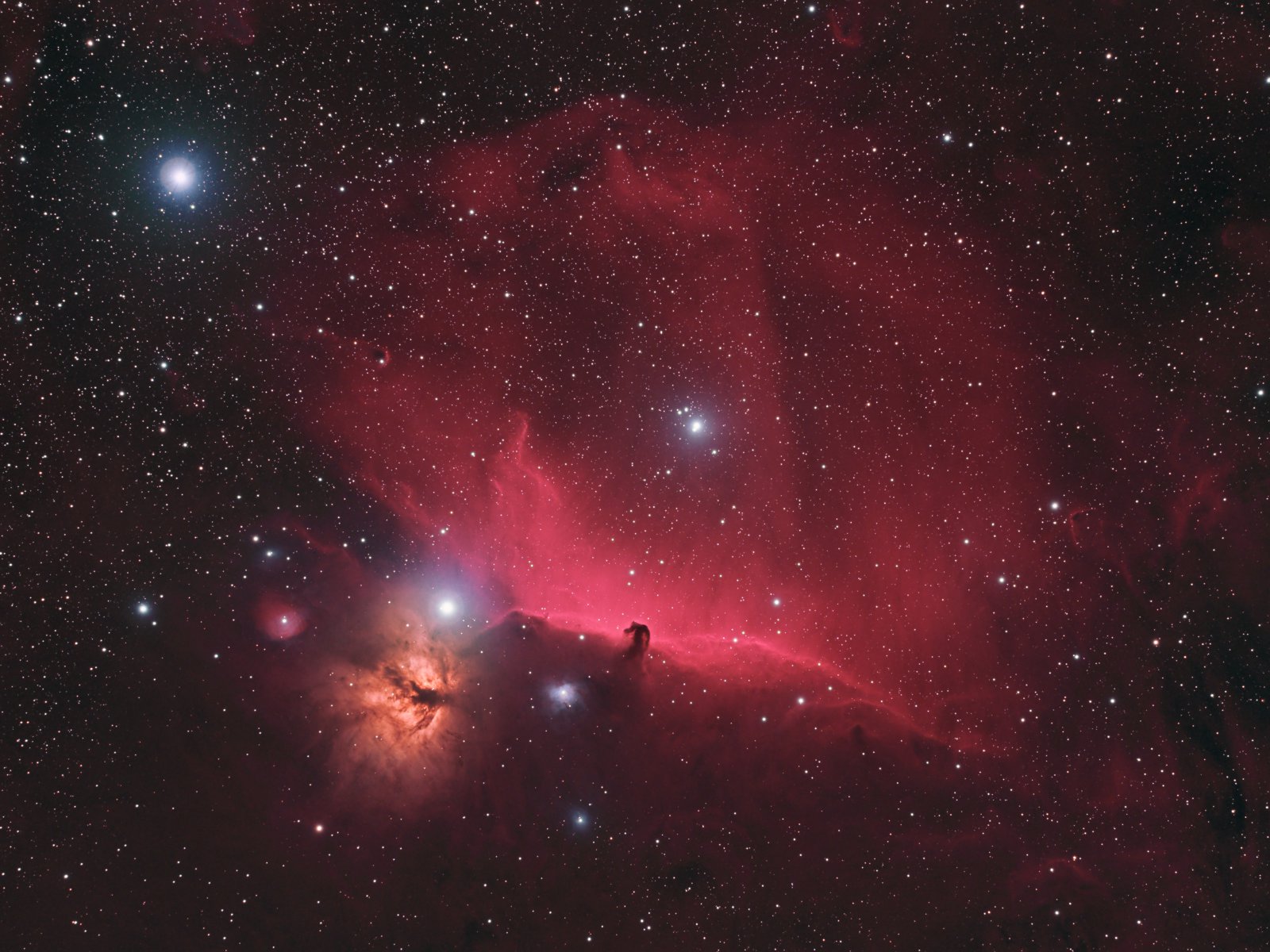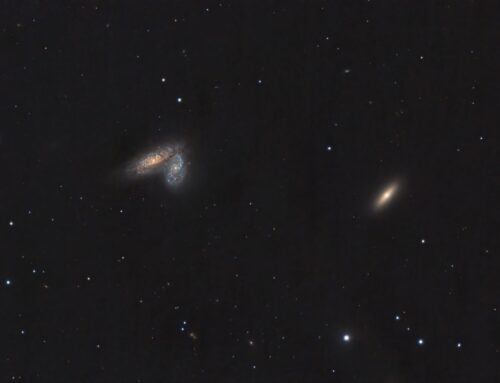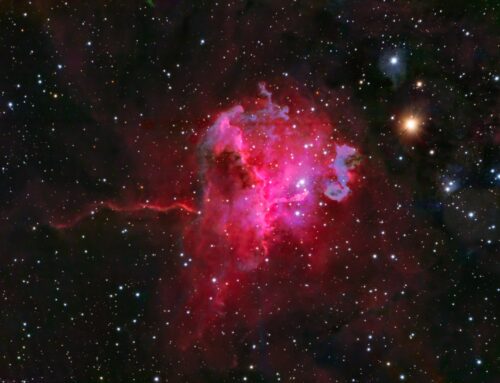Horsehead Nebula Region Wide Field
 Click image for full size version
Click image for full size version
December 31, 2019
I acquired this image during November and December 2019, using a one-shot colour camera with a narrow band filter. This region is part of a larger complex of nebulosity and star formation in Orion, known as the Orion Molecular Complex. There’s a wealth of deep-sky jewels in this image.
– IC 434 is the large, round emission nebula that dominates this field. It lies about 1,400 light years away.
– The Horsehead Nebula is a cloud of dark material blocking out the light of the red emission nebula IC 434, just below centre in this image. The Horsehead Nebula is also known as Barnard 33 (B33), being the 33rd entry in E.E. Barnard’s catalogue of dark nebulae. It’s about 1,500 light years away.
– The second brightest star in this image is Alnitak, the leftmost star in Orion’s belt, as seen from the northern hemisphere. It’s more than 700 light years away, and is a triple star, whose brightest member is a hot blue supergiant.
– At upper left, the brightest star in the field is Alnilam, the centre star in Orion’s belt. It is estimated to be 1,350 – 2,000 light years away, and has a mass 30-64.5 times that of the Sun. In the vicinity of Alnilam, William Herschel discovered a reflection nebula, NGC 1990, in 1786. However, more recent visual and photographic surveys have not revealed it, and it may not exist at all. Interestingly, Herschel described it as “spectacular” and “extremely large.”
– The Flame Nebula is below Alnitak, whose radiation powers this emission nebula. Electrons in the gas become energized by ultraviolet light and release the energy as visible light. The dark areas are made of dark gas and dust lying between us and the bright part of the nebula.
– To the lower left of the Horsehead Nebula is NGC 2023 (NGC is the revised New General Catalogue), a bluish reflection nebula. The pinkish areas in it are due to ultraviolet light causing molecular hydrogen to fluoresce, and the colour is quite different than the deeper red usually associated with hydrogen. Reflection nebulae do not glow with their own light, they are due to dust and gas reflecting starlight towards us.
– Near bottom centre is a small, whispy reflection nebula, IC 435 (IC stands for “Index Catalogue” and there are two IC supplements to the NGC).
– To the left of the Flame Nebula is an emission nebula with some reflection nebula to it. This is IC 432. Just above it is blue IC 431, a reflection nebula.
Tekkies:
Takahashi FSQ-106 ED IV @ f/3.6, QHY367C one-shot colour camera, and Optolong L-eNhance narrowband filter, Paramount MX, unguided. Acquisition, and focusing with TheSkyX. Focus with Optec DirectSync focus motor and controller. Automation with CCDCommander. Equipment control with PrimaLuce Labs Eagle 3 Pro computer. All pre-processing and processing in PixInsight. Acquired from my SkyShed in Guelph. Variable moon, average to above average transparency and fair to average seeing. Data acquired November 23-December 24, 2019.
70x10m with Optolong L-eNhance filter (Total = 11hr40m)
Image scale 2.6 arcsec per pixel
Data Reduction and Cleanup
Preprocessing: The WeightedBatchPreProcessing script was used to perform calibration, debayering, and registration of all frames. ImageIntegration followed by DrizzleIntegration with the CFA Drizzle option was used to make the master, which was then cropped.
Gradient Removal: DBE was applied using Subtraction to remove the minimal gradient that remained after integration.
Channel Registration: To improve channel registration, the RGB colour channels were extracted and aligned with StarAlignment, using Thin Plate Splines with Distortion Correction and the green channel as the reference frame. The registered colour channels were recombined with ChannelCombination.
Lightness Extraction: RGBWorkingSpace was applied to normalize the channels, and the Lightness was extracted for separate processing as described below.
Colour
Colour Balancing: The colour image was colour balanced with ColorCalibration.
Linear Noise Reduction: MultiscaleLinearTransform was used to reduce noise in the background areas, using an internal mask to protect bright structures. Layer settings for threshold and strength: Layer 1: 5.0 0.85 Layer 2: 3.5, 0.75 Layer 3: 3.0, 0.5 Layer 4: 1.0, 0.25.
Stretching: HistogramTransformation was applied to make a pleasing, bright image, with background set to an intensity of approximately 0.10.
Lightness
Deconvolution: StarMask was applied with default settings to produce a Local Deringing Support Image. A clone of the image was stretched to use as a deconvolution mask. Deconvolution was applied (200 iterations, regularized Richardson-Lucy, external PSF made using PSFImage script with about 30 stars).
Linear Noise Reduction: MultiscaleLinearTransform was used to reduce noise in the background areas, using an internal mask to protect bright structures. Layer settings for threshold and strength: Layer 1: 5.0, 0.75 Layer 2: 3.0, 0.75 Layer 3: 1.0, 0.6 Layer 4: 0.5, 0.2.
Stretching: HistogramTransformation was applied to make a pleasing, bright image, with background set to an intensity of approximately 0.10.
Recombining Lightness and Colour Images
LRGB Combination: The lightness image was applied to the RGB image using LRGBCombination with default settings.
Additional Processing
Nonlinear Noise Reduction: TGVDenoise was used in L*a*b* mode to reduce noise with a mask used to target the background areas and protect the stars (max. 1000 iterations and convergence selected for both lightness and chrominance).
Contrast Enhancement: LocalHistogramEqualization was applied twice (scale of 50 with strength 1.0; then scale of 150 with strength 0.5) using a mask to protect stars and low-signal regions of the image. The mask was a stretched version of the Lightness image with stars removed using Starnet++.
Final Steps: Background, nebula and star brightness, contrast, colour saturation were adjusted in several iterations using CurvesTransformation with masks as required. Hue was adjusted using the following expression in PixelMath without rescaling, with a star mask in place to protect the stars:
R: $T[0]
G: iif([$T[0]>0.22, 0.94*$T[1], $T[1])
B: iif([$T[0]>0.22, 1.10*$T[2], $T[2])
The DarkStructureEnhance script was applied with a strength of 0.25. The image was rescaled to its original scale of 2.6″/pixel. ICCProfileTransformation (sRGB IEC61966-2.1; Relative Colorimetric with black point compensation) was applied prior to saving as a jpg. And if you read all the way to here, congratulations. You can see the full resolution Drizzled version (1.3″ per pixel), by sending me a comment asking for it!






Beautiful image as always, really enjoy the Tek breakdown too.
Thanks Tim! Happy New Year.
Excellent image, amazing job on the processing, I always have issues with the bright stars, your control over them is note worthy. The detail in Barnard 33 is very nice as well you have captured a lot of the wispy tendrils that some times get processed out.
NGC 434 is an amazing object and always gets oohs and ahhs when I show mine at outreach events. This one is inspiring for me, want to reprocess my data using PI and see what I can come up with.
I would like to see the full resolution Drizzled version please.
Thank You
I really like this image, which includes all the features of the region in a single frame for a better sense of context, rather than each featured object in a separate frame as if floating in isolation.
Everybody has seen a closeup image of the HH Neb in a magazine or a marketing brochure or somewhere, and instantly knows (roughly) what its called. Yet almost nobody, except AP’s, even knows where it is in the sky or how small a part of the whole region it really is. To that end, your capture is educational on many levels.
I’m a couple years late coming to the party, but still, I GOTTA ask if I can see the drizzled version. Thanks !!
I didn’t use Drizzle integration for this image. Sorry 🙁